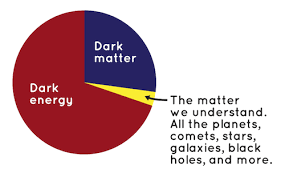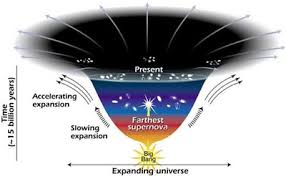Overview
The type of energy and matter that we can observe in the universe is thought to be only a small fraction of its total contents, less than 5%. Dark matter and dark energy have been theorized to make up the rest. Although scientists cannot observe either dark matter or dark energy directly, evidence for its existence comes from the expansion of the universe, fluctuations in the cosmic microwave background, and observations of very distant galaxies.
What Is Dark Matter?
Dark matter does not emit any light on the electromagnetic spectrum, so it is not a radio or infrared source. It is massive enough to cause some of the gravitational effects that have been observed. Some dark matter may be in massive black holes or other objects that are too dark to observe. Some dark matter may exist in massive particles that are not part of the standard model of physics. Since scientists are discovering new particles all the time as a result of projects such as the Large Hadron Collider, it is possible that there may be other types of particles.
Expansion of the Universe
Scientists have observed that galaxies are receding from one another, and that the furthest galaxies are receding at a slower rate than those that are closer to us. Before observations were made from the Hubble Space Telescope, the theory was that the rate of expansion might slow down as gravity pulled objects together. Although scientists do not know why the expansion rate is accelerating, they have postulated that something called “dark energy” may be repelling galaxies from one another at a faster rate. Dark matter and dark energy together account for more of the contents of the universe than the very small portion that can be easily observed.
Cosmic Microwave Background
The cosmic microwave background or CMB is a very faint background glow in all directions of space. It is thought to provide a snapshot of the conditions of the universe close to the time of the Big Bang. Some fluctuations in the CMB are thought to provide evidence of dark matter.
Observations of Distant Galaxies
Although the effects are very subtle, astronomers can measure the effects of gravitational distortion in very distant galaxy clusters that show that there are effects from stars, clouds of interstellar plasma, and something else. In these pictures taken from the Chandra X-Ray Observatory satellite in space, very hot plasma clouds are mapped as pink, and the position of dark matter is mapped as clouds of blue.
Interested in science tutoring services? Learn more about how we are assisting thousands of students each academic year.
SchoolTutoring Academy is the premier educational services company for K-12 and college students. We offer tutoring programs for students in K-12, AP classes, and college. To learn more about how we help parents and students in Midwest City, OK visit: Tutoring in Midwest City, OK




